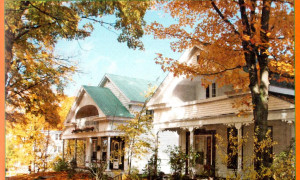Articles
Daniel Way lives at the entrance of the settlement, by the first bridge. Cloth manufacture is his trade. At the far end of the settlement, by the bridge at the foot of Chemin Madore, lives Harry Hollister. He has been operating a saw mill and a grist mill for several years.
1849…There are rumblings of discontent in Stanstead County. Its citizens are unhappy with a stagnating economy and the seeming reluctance of Canada’s colonial government to effect the changes that will encourage growth.
The waters of the Niger had attracted settlers to the area as early as 1796, long before Daniel and Lorenzo Way’s arrival. By the late 1830s, several families were established.
In September 1843, Daniel Way and the members of his family have moved into the Barnston area in a settlement that does not yet bear their name. The eldest son, Lorenzo Sweedenburg Way, is now a young man of 27 who has married Julia Ann Hodge on September 6, 1838.
1819 : Daniel and Keziah Way and their first-born Lorenzo are now settled on Lot 9, Seventh Range of Stanstead Township, between Griffin Road and Smith’s Hollow, by the Tomifobia River.
So who was waiting for Daniel Way and his young family in Canada after 1816? Remember the Gustin, the Mack and the Miller men from Marlow N.H., who were married to Esther, Ethelinda and Sally Way, Daniel’s aunts? In The History of Stanstead County, B. F.
Keziah Jaquith, Daniel Way’s future wife, was born on November 16, 1793. She was the second daughter of Jesse Jaquith and Keziah Hathorn. Jesse Jaquith’s ancestry can easily be traced back all the way to Richard Jaques, a French protestant, or ‘Huguenot’. Richard’s son, Abraham, born around 1610, settled in the Massachussets Bay Colony.
We’ll catch up with the Gustins, Macks and Millers near the U.S.-Canada border later. For now, their nephew Daniel Way, born in 1794, is growing up in Marlow, Cheshire County, NH. The town has voted six months’ schooling for all children in 1792 and since then several district schools have been built.
The Way family thus came in 1787 to the area of Marlow, Cheshire County, New Hampshire, joining some 200 souls just recently settled there. Have a look on a map…Marlow lies some 260 km North of Lyme, Connecticut…and 270 km South-East of Stanstead…Halfway… The area is beautiful.
We know that Way’s Mills was founded in the mid-19th century by Daniel Way, who is buried in Way’s Mills cemetery, up on Jordan Rd. His son, L.S. Way, followed in the footsteps of his father and operated for over half a century the woolen mill that once stood by the Niger River at the entrance of Way’s Mills.
Taproot IV: Poetry, Prose, and Images from the Eastern Townships, the latest edition of a series of anthologies published by Townshippers’ Association, has just been released.
"From Ottawa or Washington this international community is something that can not possibly exist officially. But it does still exist at the community and personal level. Our fire departments […] stand ready at all times to assist one another. Our churches and service clubs see no border when someone is in need.
“My father bought that gatherin’ tub in 1919, the year he started sugarin’. It was made by a fella name of Odd Aldridge over here in Moe’s River. He was a cooper – made washtubs, barrels, buckets… I tell ya I wouldn’t mind havin’ all the nickels and pennies worth of sap that’s gone through that tub.”
Derek Booth has just released his latest contribution to Quebec’s railway and transportation history. Quebec Central Railway – From the St. Francis to the Chaudière is published by Railfare Books, and is the third volume in Booth’s series “Railways of Southern Quebec.”
Well known Townships writer and filmmaker Louise Abbott has teamed up with her partner Niels Jensen to produce what will certainly be considered a fine addition to any library of Eastern Townships source material.
A new publication, titled (in English) Cemeteries of Austin, is now available. Produced in pamphlet format, this 20-page fold-out brochure was researched and written by local historians Serge Wagner and Maurice Langlois, and was published in 2008 by the Austin Cultural Committee.
The one-room schoolhouse, so long the focus of folklore and nostalgia, is the subject of a new book. Days to Remember: One-room Schoolhouses in the Eastern Townships of Quebec, is the culmination of years of work by the Canadian Federation of University Women (CFUW), Sherbrooke & District.
The Eastern Townships : On Lake and River, by Matthew Farfan, is still available.
Anyone with more than a passing interest in the architecture and history of the Eastern Townships, in particular that part of the Townships bordering the U.S., will be interested to know that a new book has just been published on a type of architecture that, apart from the neighbouring states of New England, is quite unique to this part of Quebec.
In Canada, heritage sites may be designated nationally, provincially and municipally. The level of designation depends on the level of significance of the site. National Historic Sites must be judged to be of national significance; provincial, of provincial significance, and so on.
